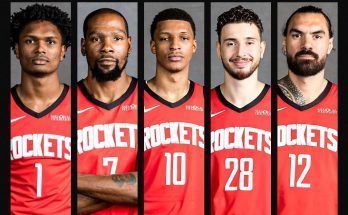“Chiefs Crowned as AFC’s Top Team Heading Into 2025, Fueling Dynasty Talk”
Chiefs crowned as the AFC’s top team heading into 2025, fueling dynasty talk, has become the kind of preseason refrain that once sounded hyperbolic but now feels almost routine around Kansas City. What began as a thrilling rise under Andy Reid and Patrick Mahomes has stretched long enough that fans, analysts, and even division rivals are asking whether we’re watching the middle chapters of one of pro football’s defining long-haul runs. Labels like “best in the AFC” always carry noise in July chatter, but when the same franchise keeps resetting the standard year after year, the noise starts to sound like a drumbeat that won’t fade.
The label matters because it changes how every other contender builds. General managers in Buffalo, Baltimore, Cincinnati, Miami, Houston, and beyond sketch off‑season boards with Kansas City in mind. Defensive coordinators spend install periods scripting disguises meant to muddy Mahomes’s pre‑snap tells and close scramble alleys. Offensive designers look for protection solutions and route answers against a Steve Spagnuolo defense that long ago shed its bend‑but‑don’t‑break stigma and now toggles between pressure illusions and post‑snap rotations that steal quarterback time. When one club alters the gravitational field of a conference, “dynasty” stops being a media indulgence and becomes an operational reality.
Start with quarterback, because in the modern NFL that position sets both the floor and the ceiling of true contention. Mahomes has already reimagined second‑reaction football, blending arm elasticity, launch‑point creativity, and coverage‑proof improvisation. Defenses can win a call, win the rush, squeeze every throwing lane—only to watch him climb, slide, reset, and generate an explosive outside structure. Sustained elite quarterback play lets a team survive injuries, cap churn, youthful receivers who need runway, and those two‑or‑three game lulls every contender endures. As long as Mahomes hovers near his own outrageous standard, Kansas City begins each season inside the Super Bowl conversation.
Yet quarterback alone does not explain why power rankers keep slotting the Chiefs at or near the top of the conference board. The supporting architecture—coaching continuity, front‑office alignment, and relentless adaptability—refreshes around the star core. Reid’s offensive framework never calcifies. It absorbs college tempo, sprint and return motion, heavy looks, compressed bunches, and classic West Coast timing as the league cycles through trends. He hands Mahomes broad freedom at the line while still dressing concepts in layers of eye candy that manufacture leverage for developing skill talent. Scheme multiplies talent; in Kansas City it also shelters it while it grows.
Spagnuolo’s defense has become the franchise’s not‑so‑secret engine. Early in the Mahomes era, Kansas City leaned on shootouts. More recently the defense has flipped scripts, winning downs with simulated pressure, creepers, late safety rotation, and carefully timed green‑dog triggers that punish backs in protection. The Chiefs can heat you with numbers or bluff pressure and bail, baiting hurried throws into rotating shells. They mix man match with zone vision, spin safeties late, and trust corners who can survive on islands long enough for the rush to close. When a team known for fireworks can also smother you, season variance shrinks.
Roster management belongs in every dynasty conversation. Contending deep into multiple Januaries while carrying a megadeal quarterback requires a conveyor belt of low‑cost contributors who become meaningful snaps before payday. Kansas City’s scouting and development pipeline has produced playable corners, rotational pass rushers, smart interior linemen, and multipurpose safeties at a clip high enough to offset inevitable veteran departures. The hits don’t all become stars; what matters is the steady stream of “good enough now, cheap enough later” players that keeps the roster’s middle class healthy and the competitive window propped open.
Cap discipline and contract structure amplify that pipeline. Creative restructures, staggered bonuses, incentive‑laden bridges, and a ruthless willingness to move on a year early rather than a year late have helped the Chiefs avoid the bloated middle‑age phase that traps many contenders. Shorter horizons on deals let the club reassess aging pillars annually and preserve flexibility for in‑season trades or opportunistic waiver strikes. Misses happen, but the macro approach—optionality over sentiment—has protected the roster’s shape around its cornerstone quarterback.
None of this erases current questions, and that’s where the “pressure cooker” aspect of being the conference favorite shows. Is the offensive line, particularly at tackle, athletic enough to handle the waves of edge length building in Baltimore and Cleveland? Can the receiver room produce steady separation if defenses bracket the top option and live in late‑rotating robber looks? How aggressively should the staff manage Travis Kelce’s snap load as mileage accumulates, and which younger targets can shoulder red‑zone volume if his usage scales back? Preseason debates turn these into national talking points because everyone measures them against a championship bar.
Injuries remain the great equalizer, yet Kansas City has repeatedly demonstrated a capacity to patch around short‑term losses without offensive identity collapse. Scheme multiplicity plus Mahomes’s command allow week‑to‑week pivots: gap runs one Sunday, RPO glance series the next, quick‑game ball distribution in bad weather, then layered flood and switch releases when matchups invite aggression. Defensively, Spagnuolo cycles personnel packages to accelerate reps for depth players early, so forced role escalations in December aren’t free‑fall experiments. Institutional memory—knowing how to win with Plan C—might be the least glamorous but most durable edge of the run.
The psychological toll of playing deep into late January (and often February) is real. Recovery windows shrink. Install calendars compress. Self‑scouting blends into new‑season prep. Reid and the locker‑room council answer by reframing each year as a fresh climb while embracing the expectation load they created. Rookies feel that standard on Day 1; veterans translate it into practice tempo, meeting habits, and accountability that persists after highlight reels fade. Culture talk can sound soft, but in a parity‑driven league the ability to re‑engage mentally after repeated glory is competitive capital.
Meanwhile, the AFC field is fierce and fluid. Josh Allen’s Bills can avalanche points in flurries that test even disciplined defenses. Joe Burrow and the Bengals, when healthy up front, stretch coverage vertically and punish single‑high looks. The Ravens marry trench physicality with evolving aerial structure and stress opponents’ tackling stamina. The Texans have flashed a young‑quarterback surge that, if sustained, could redraw playoff seeding math. Miami’s speed spacing, Jacksonville’s growth potential, and whichever surprise team rides health and turnover luck will all take swings. Being called the best simply paints the bull’s‑eye brighter.
Media debates about dynasties often reduce to ring counts, but a more revealing metric is era control—how consistently a team forces the rest of the league to react to its existence. By that lens, Kansas City already sits in historical conversation with the 2000s Patriots, 1990s Cowboys, and 1980s 49ers. The Chiefs have driven tactical copycatting: fourth‑down aggression calibrated to quarterback value, motion timing used as diagnostic and leverage tool, defensive multiplicity built to disrupt rhythm passers, cap gymnastics that front‑load flexibility around a franchise passer. Influence is legacy’s early footprint.
Yet dynasties are certified in hindsight, not crowned in July. The coming season adds evidence. Maybe an AFC rival finally aligns health, matchups, and turnover luck to seize the throne. Maybe red‑zone regression or turnover slip drags the Chiefs back to the pack. Or maybe Mahomes engineers another postseason gauntlet that forces us to expand the historical comparison set yet again. That annual suspense—teetering between prolonged excellence and true immortality—is what keeps the conversation hot enough to drive traffic and emotional investment all autumn.
For fans, the narrative is a choose‑your‑own‑emotion ride. Supporters lean into pride, wearing the target like armor. Rivals channel fatigue, eager for fresh blood atop the conference hierarchy. Neutrals just enjoy the theater: every nationally televised Chiefs game doubles as an audit of whether the “dynasty” file deserves another stamp. Engagement thrives on polarity; believers show up for validation, skeptics show up for receipts, and both clicks count the same.
If you cover the league analytically, treat Kansas City as the control variable in every preseason model. Chart how close each challenger sits relative to recent Chiefs bands in offensive efficiency, defensive EPA per play, late‑down conversion rate, turnover differential, and playoff advancement probability. Track the spread weekly. Whether the Chiefs finish first, second, or fifth in raw wins, movement of the chasing pack relative to their multi‑year baseline will tell readers what they really want to know: is the dynasty cresting, holding, or accelerating?
Until the data says otherwise, calling Kansas City the AFC’s team to beat is less about hype and more about converging trend lines. The Chiefs have the elite quarterback, adaptive coaching, resilient roster pipeline, cultural stamina, and proven postseason nerve that define extended control over a conference. Dynasty talk is not a guarantee of future rings; it is an invitation to study how a proven juggernaut defends its perch against a league engineering daily to knock it loose. That tension—the chase, the counterpunches, the inevitability questioned in real time—is what will make the 2025 ride irresistible.
As camps open and predictions fly, remember the crown is provisional but the fascination earned. Kansas City’s body of work demands a response from everyone else, and that chase is the show. Whether you root for empire or rebellion, buckle up; the AFC road still runs through Arrowhead until someone proves otherwise.



